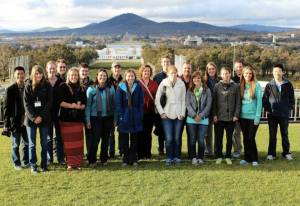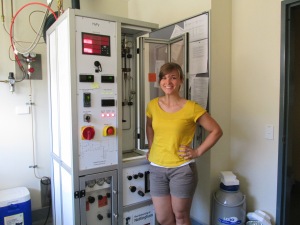
Throw another sample on the barbie
Let me start off by saying that you should never make this joke to an Australian, or really to anyone for that matter. I know it’s terrible, but I can’t help myself because it is just so perfect. I spent my summer in Australia performing hydrogen pyrolysis on soil samples, which I jokingly referred to as “barbequing” the entire time. The samples are pyrolyzed, or burned, at 550°C and come out of the instrument looking like they sat on a hot barbeque for too long. More on the hydrogen pyrolysis technique later, but for now I’ll explain how I got there in the first place.
I was awarded an NSF East Asia and Pacific Summer Institutes fellowship to study at James Cook University under Dr. Michael Bird. As their website explains,
An EAPSI award provides U.S. graduate students in science, engineering, and education: 1) first-hand research experiences in Australia, China, Japan, Korea, New Zealand, Singapore or Taiwan; 2) an introduction to the science, science policy, and scientific infrastructure of the respective location; and 3) an orientation to the society, culture and language. It is expected that EAPSI awards will help students initiate professional relationships to enable future collaboration with foreign counterparts.
U.S. Graduate students in any of the fields supported by NSF (science, engineering, and science education) are eligible to apply. The fellowship pays for round trip transportation to your host country in addition to a stipend and living allowance for the two-month duration of the program. (It should be noted that while the stipend and living allowance are generous, the fellowship does not cover any research-related costs, which is an issue for some.) As an applicant, you identify potential host researchers in up to three of the countries listed above and propose a short-term research project that you can perform under their oversight.

ASIDE: At our pre-departure orientation in Washington, DC, the East Asia and Pacific Program Head highlighted this year’s low application rate for the EAPSI fellowships. He seemed convinced that it was due to Hurricane Sandy, but it was probably also because of lower rates of advertising at graduate institutions. He asked us to spread the word, so here is my personal advertisement for the EAPSI fellowship. YOU SHOULD ALL APPLY! It is a great opportunity to travel, meet new people, make connections with other labs and researchers, and get a lot of productive work done in a short period of time. It is especially good for students who are looking for another chapter of their thesis, or who want to repeat experiments in new locations.
The program is only two months long (8 weeks for most locations, 10 weeks for Japan), and with the time it takes to get through the language barrier and get acquainted with a new institution, the possibilities for projects can be limited. I chose Australia to avoid a language barrier, but I still had to change my research project due to the time constraint. I originally proposed to identify several field sites across Australia that I could use to study the effects of temperature on soil carbon dynamics. Dr. Bird immediately questioned whether this was feasible, given the time it would take to travel to all of the potential sites and narrow them down, and suggested that I instead come up with an experiment involving a highly specialized hydrogen pyrolysis rig that he had in his lab. There are only a few of these in the world, so this was a very unique opportunity.
Luckily for me, it was easy to come up with a relevant set of soil samples to measure. I study how carbon is stabilized in soils, and pyrogenic carbon, or charcoal, is thought to be one form of highly stable soil carbon (although some studies, such as this one and this one, show that not all pyrogenic carbon is as stable as we thought). Since hydrogen pyrolysis is used to isolate pyrogenic carbon, I proposed to figure out how much pyrogenic carbon is in different parts of the soil (for example, how much is lightweight and particulate, and how much is stuck on the tiny clay particles?), how quickly it turns over, and whether different management practices, such as tillage, can affect it. My plan was to ship soil samples that were already prepared and characterized for a previous project to Australia, and to perform hydrogen pyrolysis on them. In addition to the measurements that we had already taken on these soils, measuring the pyrogenic carbon component would give us a really comprehensive understanding of the carbon story.
So it was pretty straightforward, right? All I had to do was ship the soils, and I’d be ready to go. Not so fast. As anyone who has tried to ship biological samples to Australia can tell you, they make it anything but straightforward. I knew this would be an issue, so I gave myself a generous 5-week cushion between when I shipped that samples from the US, and when I would want to have them in Australia. Long story short, I got my samples 3 weeks late, a total of 8 weeks after I originally shipped them. They were held in customs, held at the irradiation center, stuck in transit, you name it. It was a headache. The upside is that the delay gave me time to get acquainted with the lab, my fellow lab mates, and go for a hike or two (or three or four). Once they did arrive, I had a detailed spreadsheet of which samples I needed to run and how many hours it would take (over 150) that helped keep me on track. In the ensuing weeks, I was able to get all of my samples run in record time, finishing only a couple of days before my flight home. I even managed to slip in a long weekend in Melbourne. Success!

I have to give a lot of credit to my wonderful lab mates at JCU, and to the lab gods for preventing any major mechanical issues with the hydrogen pyrolysis rig. Overall, my time in Australia was enjoyable and productive, and I would highly recommend that anyone interested in the EAPSI fellowship look it up and apply. If you have any questions or comments about EAPSI or hydrogen pyrolysis, feel free to post them in the comments section below.